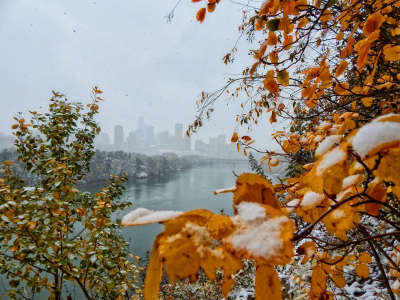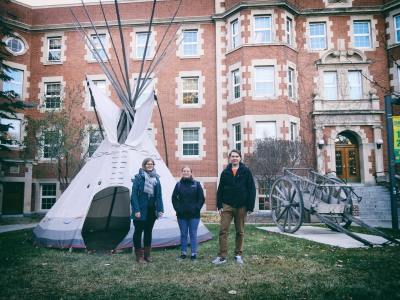- ArcTrain
- Research stays abroad
- Research stay at the University of Alberta (HN, AB, NS)
Research stay at the University of Alberta (HN, AB, NS)
Summary
In autumn/winter 2018, we had the opportunity to spend some weeks at the University of Alberta in Edmonton, Canada, working with our Canadian ArcTrain supervisor Paul Myers in the Ocean Modeling group. During our time in Edmonton, we were introduced into working with the NEMO ocean model and its output. Whereas in Bremen, our work is focused on analyzing observational ocean data, getting the chance to become acquainted with ocean modeling was a very interesting and valuable experience for us. In late October/early November, we also participated in the ArcTrain Annual Meeting which took place in Québec and which gave us the opportunity to meet our German supervisors again after some time as well as all the other Canadian and German ArcTrain students and PIs.
Apart from the obvious scientific benefits, our stay in Edmonton was also very valuable on a more personal level: we got the chance to broaden our network and to build new friendships which hopefully will lead to some further collaboration and exchange. Moreover, we experienced very different seasons from a warm Canadian summer and sunny autumn to a cold Canadian winter starting already with some snowfall in early September.

Aleksei
My research stay in Edmonton lasted for 4 months. I worked with the output of the model NEMO with the ANHA4-SPG12 and ANHA4-SPG12-LAB60 configurations. They have the spatial resolution of 1/12° and 1/60° respectively, provide the three-dimensional view on the North-Western Atlantic region and allow answering the questions of my PhD project, such as refining the position of Deep Western Boundary Current and estimation areas of detachment the water from its main axis. These tasks cannot be solved with the satellite data because the current is deep and invisible from the surface. Observational data are limited and do not provide wide spatial and temporal coverage. Consequently, verified model output has significant importance for the progress in the topic. Additionally, I've used the Lagrangian trajectory tool ARIANE to estimate the pathways of the Deep Western Boundary Current.
All in all, my research stay and working in with the model output were interesting and very useful for the understanding the ocean circulation in my research area.
Natalia
My research stay at the University of Alberta (UofA) lasted from July, 30th till November, 26th. The main work was connected with the modeling of vertical heat and freshwater fluxes in the subpolar North Atlantic. Mostly, I used the NEMO v3.4 model with configuration ANHA12. There were also several additional tasks I’ve tried to solve. I did several sensitivity experiments with the model to understand how realistic the buoyancy field is. The offline Lagrangian trajectory tool ARIANE was applied to the model output velocity field to understand how the model works in the Deep Water Formation Region in the Labrador Sea and how vertical transformations of water masses due to deep convection are realized. My personal interest was linked to the Greenland meltwater studies. I calculated vertical diffusive fluxes of the Greenland meltwater with the help of ANHA12 and ANHA60 models and my observed mixing rates. I didn’t work with ocean models previously, that’s why the experience I’ve got during the research stay is so important for my understanding of global ocean system, future studies, and carrier. I’m grateful to my Canadian supervisor Prof. Paul G. Myers for the organization of my stay at the UofA, support and important discussions of my ideas and results. I’m thankful to my colleagues from Paul Myers’ group, EAS, UofA, for their help, support, and invaluable advice. I would like to thank ArcTrain for the financial support of my 4 months stay in Canada.
Hannah
During my 3.5 months research stay in Edmonton, my work consisted of different tasks: I set up a sensitivity study concerning the influence of the atmospheric forcing on the ocean circulation in the ANHA4 (ANHA names the regional configuration of the NEMO model covering the Arctic and Northern Hemisphere Atlantic, 4 means that the model has a ¼° resolution) regional configuration of the NEMO model. Furthermore, I analyzed existing model output from the ANHA12 (1/12° resolution) model run and compared it to the observational data I have been analyzing in Bremen. To be able to better understand differences between the model output and the observational data and to study the pathways of ocean currents in the model in general, I also used the offline Lagrangian trajectory tool ARIANE which calculates float trajectories from the model output velocity field. Working with the model and the ARIANE tool was a completely new and very interesting experience for me and I am very thankful for all the support I got during this time from all ocean modelling group members.



